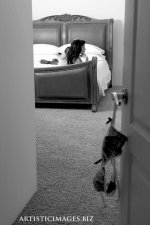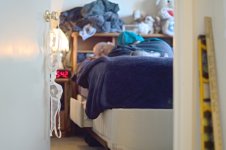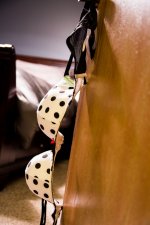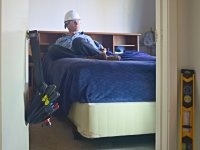So I'm trying to understand the relationship between DoF, Focal Length, and focus on DoF - not only to expand my knowledge, but for an upcoming photo project I've got brewing. So I've got my wife somewhat on board with doing a private boudoir shoot in the next month or so.
As a hobbyist and after doing some reading and experimenting - it seems as though I know some about this subject but I get confused a bit when I put it in practice.
For example, I'm trying to get a shot like this:

Pretty much same setup, however the bed in my case is probably 2 feet closer to the door.
I set up the shot to play around with (no wife involved just yet..) and I'm trying to get the door handle in focus, but really blow out the rest of the bedroom - but at least the subject that may be laying on the bed.
I tried with the Sigma 17-50 2.8. AF on the brassiere - and whether I'm at 17mm or 50mm shooting at f/2.8 if I stand 3 or so feet back from the door the brassiere is in focus, but the bed is way more in focus than I'd like. If I get a little closer to the brassiere, I can then get the background blown out as I like - however due to the way the house is configured I'm not sure I can get as much in frame as I'd like without a much wider lens to get the DoF I'm looking for.
My perception that at a reasonable focus distance (3 feet or so) shooting at f/2.8 I should be able to get the subject in focus and the background much more out of focus. However, adjusting focal length had little effect - getting closer to the subject and thus getting a closer focus distance seemed to do the trick. What's more important here - focal length or focus distance? Given the same aperture (say f/2.8) will a shorter focal length or longer focal length give me shallower depth of field?
I didn't bust out the primes, but I have a 35 f/1.8 and a 50 f/1.8 but I think that might be too much telephoto for this. I found out the local photo store rents glass for pretty cheap - I can get a 14-24 from Friday to Monday morning for $35. I might try that, but I'd like to understand this concept a little better.
I can post some samples if requested.
Thanks for any advice!
As a hobbyist and after doing some reading and experimenting - it seems as though I know some about this subject but I get confused a bit when I put it in practice.
For example, I'm trying to get a shot like this:

Pretty much same setup, however the bed in my case is probably 2 feet closer to the door.
I set up the shot to play around with (no wife involved just yet..) and I'm trying to get the door handle in focus, but really blow out the rest of the bedroom - but at least the subject that may be laying on the bed.
I tried with the Sigma 17-50 2.8. AF on the brassiere - and whether I'm at 17mm or 50mm shooting at f/2.8 if I stand 3 or so feet back from the door the brassiere is in focus, but the bed is way more in focus than I'd like. If I get a little closer to the brassiere, I can then get the background blown out as I like - however due to the way the house is configured I'm not sure I can get as much in frame as I'd like without a much wider lens to get the DoF I'm looking for.
My perception that at a reasonable focus distance (3 feet or so) shooting at f/2.8 I should be able to get the subject in focus and the background much more out of focus. However, adjusting focal length had little effect - getting closer to the subject and thus getting a closer focus distance seemed to do the trick. What's more important here - focal length or focus distance? Given the same aperture (say f/2.8) will a shorter focal length or longer focal length give me shallower depth of field?
I didn't bust out the primes, but I have a 35 f/1.8 and a 50 f/1.8 but I think that might be too much telephoto for this. I found out the local photo store rents glass for pretty cheap - I can get a 14-24 from Friday to Monday morning for $35. I might try that, but I'd like to understand this concept a little better.
I can post some samples if requested.
Thanks for any advice!






